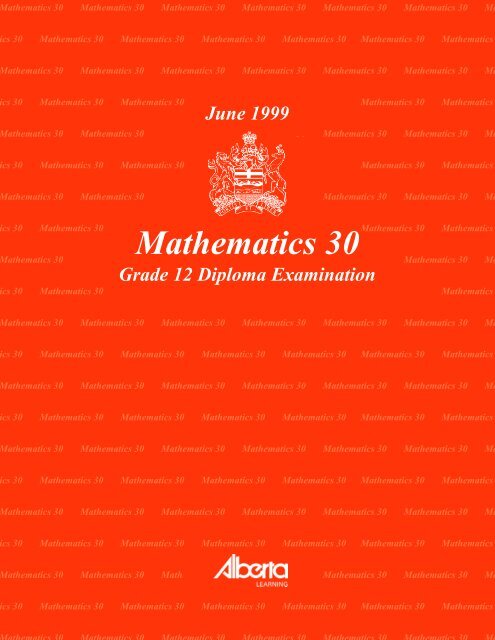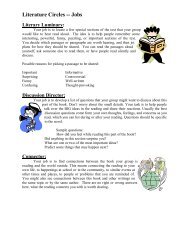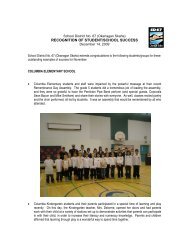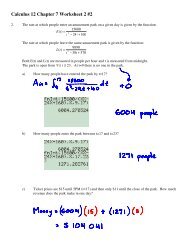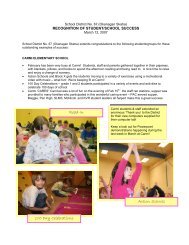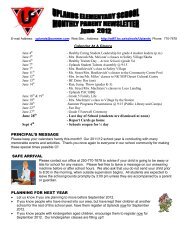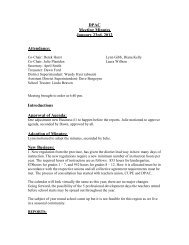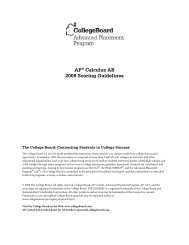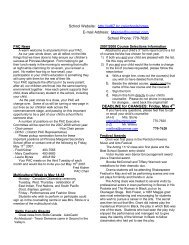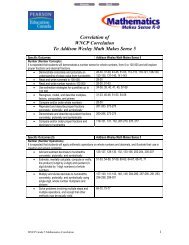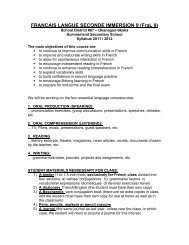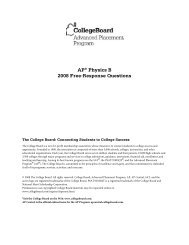Mathematics 30 June 1999 Grade 12 Diploma Exam
Mathematics 30 June 1999 Grade 12 Diploma Exam
Mathematics 30 June 1999 Grade 12 Diploma Exam
Create successful ePaper yourself
Turn your PDF publications into a flip-book with our unique Google optimized e-Paper software.
athematics <strong>30</strong> <strong>Mathematics</strong> <strong>30</strong> <strong>Mathematics</strong> <strong>30</strong> <strong>Mathematics</strong> <strong>30</strong> <strong>Mathematics</strong> <strong>30</strong> <strong>Mathematics</strong> <strong>30</strong> Ma<br />
cs <strong>30</strong> <strong>Mathematics</strong> <strong>30</strong> <strong>Mathematics</strong> <strong>30</strong> <strong>Mathematics</strong> <strong>30</strong> <strong>Mathematics</strong> <strong>30</strong> <strong>Mathematics</strong> <strong>30</strong> <strong>Mathematics</strong><br />
athematics <strong>30</strong> <strong>Mathematics</strong> <strong>30</strong> <strong>Mathematics</strong> <strong>30</strong> <strong>Mathematics</strong> <strong>30</strong> <strong>Mathematics</strong> <strong>30</strong> <strong>Mathematics</strong> <strong>30</strong> Ma<br />
cs <strong>30</strong> <strong>Mathematics</strong> <strong>30</strong> <strong>Mathematics</strong> <strong>30</strong> <strong>Mathematics</strong> <strong>30</strong> <strong>Mathematics</strong> <strong>30</strong> <strong>Mathematics</strong> <strong>30</strong> <strong>Mathematics</strong><br />
<strong>June</strong> <strong>1999</strong><br />
athematics <strong>30</strong> <strong>Mathematics</strong> <strong>30</strong> <strong>Mathematics</strong> <strong>30</strong> <strong>Mathematics</strong> <strong>30</strong> <strong>Mathematics</strong> <strong>30</strong> <strong>Mathematics</strong> <strong>30</strong> Ma<br />
cs <strong>30</strong> <strong>Mathematics</strong> <strong>30</strong> <strong>Mathematics</strong> <strong>30</strong> <strong>Mathematics</strong> <strong>30</strong> <strong>Mathematics</strong> <strong>30</strong> <strong>Mathematics</strong> <strong>30</strong> <strong>Mathematics</strong><br />
athematics <strong>30</strong> <strong>Mathematics</strong> <strong>30</strong> <strong>Mathematics</strong> <strong>30</strong> <strong>Mathematics</strong> <strong>30</strong> <strong>Mathematics</strong> <strong>30</strong> <strong>Mathematics</strong> <strong>30</strong> Ma<br />
cs <strong>30</strong> <strong>Mathematics</strong> <strong>30</strong> <strong>Mathematics</strong> <strong>30</strong> <strong>Mathematics</strong> <strong>30</strong> <strong>Mathematics</strong> <strong>30</strong> <strong>Mathematics</strong> <strong>30</strong> <strong>Mathematics</strong><br />
<strong>Mathematics</strong> <strong>30</strong><br />
athematics <strong>30</strong> <strong>Mathematics</strong> <strong>30</strong> <strong>Mathematics</strong> <strong>30</strong> <strong>Mathematics</strong> <strong>30</strong> <strong>Mathematics</strong> <strong>30</strong> <strong>Mathematics</strong> <strong>30</strong> Ma<br />
<strong>Grade</strong> <strong>12</strong> <strong>Diploma</strong> <strong>Exam</strong>ination<br />
cs <strong>30</strong> <strong>Mathematics</strong> <strong>30</strong> <strong>Mathematics</strong> <strong>30</strong> <strong>Mathematics</strong> <strong>30</strong> <strong>Mathematics</strong> <strong>30</strong> <strong>Mathematics</strong> <strong>30</strong> <strong>Mathematics</strong><br />
athematics <strong>30</strong> <strong>Mathematics</strong> <strong>30</strong> <strong>Mathematics</strong> <strong>30</strong> <strong>Mathematics</strong> <strong>30</strong> <strong>Mathematics</strong> <strong>30</strong> <strong>Mathematics</strong> <strong>30</strong> Ma<br />
cs <strong>30</strong> <strong>Mathematics</strong> <strong>30</strong> <strong>Mathematics</strong> <strong>30</strong> <strong>Mathematics</strong> <strong>30</strong> <strong>Mathematics</strong> <strong>30</strong> <strong>Mathematics</strong> <strong>30</strong> <strong>Mathematics</strong><br />
athematics <strong>30</strong> <strong>Mathematics</strong> <strong>30</strong> <strong>Mathematics</strong> <strong>30</strong> <strong>Mathematics</strong> <strong>30</strong> <strong>Mathematics</strong> <strong>30</strong> <strong>Mathematics</strong> <strong>30</strong> Ma<br />
cs <strong>30</strong> <strong>Mathematics</strong> <strong>30</strong> <strong>Mathematics</strong> <strong>30</strong> <strong>Mathematics</strong> <strong>30</strong> <strong>Mathematics</strong> <strong>30</strong> <strong>Mathematics</strong> <strong>30</strong> <strong>Mathematics</strong><br />
athematics <strong>30</strong> <strong>Mathematics</strong> <strong>30</strong> <strong>Mathematics</strong> <strong>30</strong> <strong>Mathematics</strong> <strong>30</strong> <strong>Mathematics</strong> <strong>30</strong> <strong>Mathematics</strong> <strong>30</strong> Ma<br />
cs <strong>30</strong> <strong>Mathematics</strong> <strong>30</strong> <strong>Mathematics</strong> <strong>30</strong> <strong>Mathematics</strong> <strong>30</strong> <strong>Mathematics</strong> <strong>30</strong> <strong>Mathematics</strong> <strong>30</strong> <strong>Mathematics</strong><br />
athematics <strong>30</strong> <strong>Mathematics</strong> <strong>30</strong> <strong>Mathematics</strong> <strong>30</strong> <strong>Mathematics</strong> <strong>30</strong> <strong>Mathematics</strong> <strong>30</strong> <strong>Mathematics</strong> <strong>30</strong> Ma<br />
cs <strong>30</strong> <strong>Mathematics</strong> <strong>30</strong> <strong>Mathematics</strong> <strong>30</strong> <strong>Mathematics</strong> <strong>30</strong> <strong>Mathematics</strong> <strong>30</strong> <strong>Mathematics</strong> <strong>30</strong> <strong>Mathematics</strong><br />
athematics <strong>30</strong> <strong>Mathematics</strong> <strong>30</strong> <strong>Mathematics</strong> <strong>30</strong> <strong>Mathematics</strong> <strong>30</strong> <strong>Mathematics</strong> <strong>30</strong> <strong>Mathematics</strong> <strong>30</strong> Ma<br />
cs <strong>30</strong> <strong>Mathematics</strong> <strong>30</strong> <strong>Mathematics</strong> <strong>30</strong> <strong>Mathematics</strong> <strong>30</strong> <strong>Mathematics</strong> <strong>30</strong> <strong>Mathematics</strong> <strong>30</strong> <strong>Mathematics</strong>
<strong>June</strong> <strong>1999</strong><br />
<strong>Mathematics</strong> <strong>30</strong><br />
<strong>Grade</strong> <strong>12</strong> <strong>Diploma</strong> <strong>Exam</strong>ination<br />
Description<br />
Time: 2.5 h. This examination was<br />
developed to be completed in 2.5 h;<br />
however, you may take an additional<br />
0.5 h to complete the examination.<br />
This is a closed-book examination<br />
consisting of<br />
•40 multiple-choice and 9 numericalresponse<br />
questions, of equal value,<br />
worth 70% of the examination<br />
•3 written-response questions, of equal<br />
value, worth <strong>30</strong>% of the examination<br />
A tear-out formula sheet and a z-score<br />
page are included in this booklet.<br />
All graphs on this examination are<br />
computer-generated.<br />
Note: The perforated pages at the<br />
back of this booklet may be torn out<br />
and used for your rough work.<br />
No marks will be given for work done<br />
on the tear-out pages.<br />
Instructions<br />
•You are expected to provide your own<br />
scientific calculator.<br />
•Use only an HB pencil for the<br />
machine-scored answer sheet.<br />
•Fill in the information required on the<br />
answer sheet and the examination<br />
booklet as directed by the presiding<br />
examiner.<br />
•Read each question carefully.<br />
•Consider all numbers used in the<br />
questions to be exact numbers and not<br />
the result of a measurement.<br />
•If you wish to change an answer, erase<br />
all traces of your first answer.<br />
•Do not fold the answer sheet.<br />
•The presiding examiner will collect<br />
your answer sheet and examination<br />
booklet and send them to Alberta<br />
Learning.<br />
•Now turn this page and read the<br />
detailed instructions for answering<br />
machine-scored and written-response<br />
questions.
Multiple Choice<br />
• Decide which of the choices best<br />
completes the statement or answers<br />
the question.<br />
• Locate that question number on the<br />
separate answer sheet provided and fill<br />
in the circle that corresponds to your<br />
choice.<br />
<strong>Exam</strong>ple<br />
This examination is for the subject of<br />
A. biology<br />
B. physics<br />
C. chemistry<br />
D. mathematics<br />
Answer Sheet<br />
A B C D<br />
Numerical Response<br />
• Record your answer on the answer sheet<br />
provided by writing it in the boxes and<br />
then filling in the corresponding circles.<br />
• If an answer is a value between 0 and 1<br />
(e.g., 0.7), then be sure to record the 0<br />
before the decimal place.<br />
• Enter the first digit of your answer in<br />
the left-hand box and leave any<br />
unused boxes blank.<br />
<strong>Exam</strong>ples<br />
Calculation Question and Solution<br />
Correct to the nearest tenth of a radian, 40°<br />
is equal to __________ rad.<br />
40° = 0.6981317008 . . . rad<br />
=0.7<br />
(Record your answer in the numerical-response<br />
section on the answer sheet.)<br />
Record 0.7 on the<br />
answer sheet 0.7<br />
. .<br />
0 0 0 0<br />
1 1 1 1<br />
2 2 2 2<br />
3 3 3 3<br />
4 4 4 4<br />
5 5 5 5<br />
6 6 6 6<br />
7 7 7 7<br />
8 8 8 8<br />
9 9 9 9<br />
ii
Written Response<br />
Correct-Order Question and Solution<br />
When the following subjects are arranged in<br />
alphabetical order, the order is ______ .<br />
1 biology<br />
2 physics<br />
3 chemistry<br />
4 mathematics<br />
(Record all four digits of your answer in the<br />
numerical-response section on the answer<br />
sheet.)<br />
Answer: 1342<br />
• Write your answers in the examination<br />
booklet as neatly as possible.<br />
• For full marks, your answers must<br />
address all aspects of the question.<br />
• Descriptions and/or explanations of<br />
concepts must be correct and include<br />
pertinent ideas, diagrams, calculations,<br />
and formulas.<br />
• Your answers must be presented<br />
in a well-organized manner using<br />
complete sentences and correct units.<br />
Record 1342 on the<br />
answer sheet 1 3 4 2<br />
. .<br />
0 0 0 0<br />
1 1 1 1<br />
2 2 2 2<br />
3 3 3 3<br />
4 4 4 4<br />
5 5 5 5<br />
6 6 6 6<br />
7 7 7 7<br />
8 8 8 8<br />
9 9 9 9<br />
iii
1. The function f (x) = x 3 – 6 is<br />
A. a linear function<br />
B. a quadratic function<br />
C. a polynomial function<br />
D. an exponential function<br />
Use the following information to answer the next question.<br />
The partial graph of a fifth-degree polynomial function, P, is shown below.<br />
All the x-intercepts are integers.<br />
P(x)<br />
80<br />
70<br />
60<br />
50<br />
40<br />
<strong>30</strong><br />
20<br />
10<br />
–4 –3 –2 –1<br />
–10<br />
1 2 3<br />
–20<br />
x<br />
2. The multiplicity of the factor (x + 3) of P is<br />
A. 1<br />
B. 2<br />
C. 3<br />
D. 5<br />
1
Use the following information to answer the next question.<br />
A student is given the partial graph of a third-degree polynomial function,<br />
y = P(x), as shown below. The x-intercepts of the graph are – 4, 0, and 2.<br />
y<br />
35<br />
<strong>30</strong><br />
25<br />
20<br />
15<br />
10<br />
5<br />
–6 –5 –4 –3 –2 –1<br />
–5<br />
1 2 3 4 5 6<br />
–10<br />
–15<br />
–20<br />
–25<br />
x<br />
3. In order to determine the equation for P, the student will also require the<br />
A. range when x > 2<br />
B. value of the y-intercept<br />
C. values of any additional x-intercepts<br />
D. coordinates of a point on the graph of y = P(x), such that y ≠ 0<br />
4. A third-degree polynomial function is given by P(x) = (x – 2)(x + 3)(x + 4).<br />
If another polynomial function Q(x) = kP(x), k > 1, then the graph of y = Q(x)<br />
must have<br />
A. a y-intercept that is less than –24<br />
B. a y-intercept that is greater than –24<br />
C. k more x-intercepts than the graph of P(x)<br />
D. x-intercepts different from those of the graph of P(x)<br />
2
Use the following information to answer the next question.<br />
The partial graph of the polynomial function P(x) = ax 3 + bx 2 + cx + d is<br />
shown below. The graph of y = Q(x) is the reflection of y = P(x) in the<br />
x-axis.<br />
y<br />
y = P(x)<br />
x<br />
y = Q(x)<br />
5. According to this information, the equation of the polynomial function Q is<br />
A. Q(x) = ax 3 + bx 2 + cx – d<br />
B. Q(x) = –ax 3 + bx 2 + cx + d<br />
C. Q(x) = –ax 3 + bx 2 + cx – d<br />
D. Q(x) = –ax 3 – bx 2 – cx – d<br />
3
Use the following information to answer the next question.<br />
The partial graph of a cubic polynomial function, y = P(x), is shown below.<br />
y<br />
6<br />
5<br />
4<br />
3<br />
2<br />
1<br />
–3 –2 –1<br />
–1<br />
1 2 3<br />
–2<br />
–3<br />
–4<br />
–5<br />
–6<br />
–7<br />
–8<br />
–9<br />
–10<br />
–11<br />
–<strong>12</strong><br />
–13<br />
–14<br />
–15<br />
x<br />
6. When P(x) is divided by (x + 2), the remainder is<br />
A. negative<br />
B. zero<br />
C. positive<br />
D. undefined<br />
7. If the factored form of 3x 3 – 2x 2 – 17x – <strong>12</strong> is (x – 3)(x + 1)(ax + b),<br />
then (ax + b) is<br />
A. 3x – 4<br />
B. 3x + 4<br />
C. –3x + 4<br />
D. –3x – 4<br />
4
Numerical Response<br />
1. The polynomial function P(x) = 4x 3 – 18x 2 – x – 45 is divided by D(x) = x – 5.<br />
The quotient is of the form Q(x) = ax 2 + bx + c. Determine the values of a, b,<br />
and c, where a, b, and c ∈ N.<br />
a is ___________ (Record in the first column.)<br />
b is ___________ (Record in the second column.)<br />
c is ___________ (Record in the third column.)<br />
(Record your answer in the numerical-response section on the answer sheet.)<br />
8. An angle of<br />
A. 52°<br />
B. 39°<br />
C. 26°<br />
D. 13°<br />
13π<br />
90<br />
radians, expressed in degrees, is<br />
9. If 2 sinθ cosθ – cosθ = 0, 0 ≤ θ < 2π, then the values of θ are<br />
A.<br />
B.<br />
C.<br />
D.<br />
0,<br />
π<br />
, π,<br />
and<br />
5π<br />
3 3<br />
0,<br />
π<br />
,<br />
5π<br />
, and<br />
3π<br />
3 6 2<br />
π<br />
,<br />
π<br />
, π,<br />
and<br />
5π<br />
6 2 3<br />
π<br />
,<br />
π<br />
,<br />
5π<br />
, and<br />
3π<br />
6 2 6 2<br />
5
10. A student is investigating the effects of changing the values of the parameters<br />
a, b, c, and d in the equation y = a sin[b(θ + c)] + d. The graph of each of the<br />
following functions is plotted:<br />
f (θ )=sinθ<br />
g(θ) = 2 sinθ<br />
h(θ )=sin2θ<br />
k(θ)=sin(θ + 2)<br />
l(θ )=sinθ + 2<br />
The equation whose graph will have the same θ -intercepts as the graph<br />
of y = f (θ ) is<br />
A. y = g(θ )<br />
B. y = h(θ )<br />
C. y = k(θ )<br />
D. y = l(θ )<br />
11.<br />
⎛3θ⎞<br />
⎛θ 3θ θ<br />
An equivalent expression for cos⎜<br />
2<br />
⎟ cos⎜ 2<br />
sin<br />
2<br />
sin<br />
⎝ ⎠ ⎝ ⎠ ⎟ + ⎛ ⎞ ⎛<br />
⎜ ⎟ ⎜ ⎞ ⎝ ⎠ ⎝2⎠ A. sin(2θ )<br />
B. cos(2θ )<br />
C. sin(θ )<br />
D. cos(θ )<br />
<strong>12</strong>. An equivalent expression for<br />
A. sin 2 x<br />
B. sin x<br />
C. cos 2 x<br />
D. cos x<br />
(sin x)(cos<br />
x)<br />
tan x<br />
is<br />
6
13. If (π, –6) satisfies the equation h ( θ)<br />
= A sin<br />
⎛ ⎞<br />
⎜θ<br />
+<br />
π<br />
− 4<br />
2<br />
⎟ , then the value of A is<br />
⎝ ⎠<br />
A. 10<br />
B. 6<br />
C. 4<br />
D. 2<br />
Numerical Response<br />
2. An arc of a circle with a radius of 100 cm subtends a central angle of 1.4 radians.<br />
The length of the arc, correct to the nearest centimetre, is __________ cm.<br />
(Record your answer in the numerical-response section on the answer sheet.)<br />
7
Use the following information to answer the next question.<br />
The partial graph of the function f (θ ) = a sin(θ + c) + d is shown below.<br />
f( )<br />
40<br />
P<br />
35<br />
<strong>30</strong><br />
25<br />
20<br />
15<br />
10<br />
5<br />
Q<br />
π π 3π 2π<br />
2 2<br />
The graph has a maximum at P(0, 37) and a minimum at Q(π, 5).<br />
Numerical Response<br />
3. Based on the information above, the value of d, correct to the nearest whole<br />
number, is __________.<br />
(Record your answer in the numerical-response section on the answer sheet.)<br />
8
14. Given that log b 64 = 3 , the value of b is<br />
2<br />
A. 16<br />
B. 42 2 3<br />
C. 96<br />
D. 5<strong>12</strong><br />
15. If log 5 (<strong>12</strong>5x) = 25, then the value of x is<br />
A. 5 28<br />
B. 5 22<br />
25<br />
C. 5 3<br />
D. 5<br />
9
16. A student wants to use a graphing calculator to graph y = log 5 x. If the calculator<br />
accepts only common logarithms, then an equivalent equation that could be used to<br />
obtain the graph is<br />
A. y<br />
= log x<br />
log 5<br />
B. y = log x − log 5<br />
C. y = 5 log x<br />
D.<br />
x<br />
y = log 5<br />
Use the following information to answer the next question.<br />
t<br />
h<br />
Half-life of Phosphorus-32<br />
⎛ ⎞<br />
A( t)<br />
= A<br />
1<br />
o ⎜ ⎟ , where A(t) = the mass present at time t<br />
⎝ 2 ⎠<br />
A o<br />
= A(0)<br />
t = time<br />
h = half-life of phosphorus-32<br />
17. The half-life of phosphorus-32 is 14.3 days. The length of time that it will take<br />
96.2 g of phosphorus-32 to decay to <strong>12</strong>.5 g, to the nearest day, is<br />
A. 8 days<br />
B. 26 days<br />
C. 42 days<br />
D. 52 days<br />
10
Use the following information to answer the next question.<br />
The partial graphs of f (x) = 1 + 3 log 2 x and g(x) = 4 – log 2 x are shown<br />
below. The graphs intersect at point A.<br />
y<br />
7<br />
y = f(x)<br />
6<br />
5<br />
4<br />
3<br />
2<br />
A<br />
y = g(x)<br />
1<br />
1 2 3 4<br />
x<br />
–1<br />
–2<br />
–3<br />
18. Based on the information above, the x-coordinate of point A can be determined<br />
by solving<br />
A. 3 log 2 x + 1 = 0<br />
B. 4 – log 2 x = 0<br />
C. log 2 x = 5 2<br />
D. log 2 x = 3 4<br />
11
19. If log 2 b = c , then log 4 b equals<br />
A.<br />
c<br />
2<br />
B. c 2<br />
C. 2c<br />
D. c<br />
20. The lead concentration of human blood, C B , measured in µg/100 mL, increases<br />
with the mean lead concentration of the environmental air to which a person is<br />
exposed, C L , measured in µg/m 3 , according to the formula C B = 60 log C L – 20.<br />
If the lead concentration of samples of environmental air has values between<br />
5.0 and 100.0 µg/m 3 , then the range of lead content in human blood is<br />
A. 21.9 to 100.0 µg/100 mL<br />
B. 20.0 to 60.0 µg/100 mL<br />
C. 2.6 to 100.0 µg/100 mL<br />
D. 2.1 to 6.0 µg/100 mL<br />
<strong>12</strong>
Numerical Response<br />
4. An exponential function f is defined by f (x) = 7(1.5) x – 6 . If f (k) = 91, then<br />
the value of k, correct to the nearest tenth, is __________.<br />
(Record your answer in the numerical-response section on the answer sheet.)<br />
Use the following information to answer the next question.<br />
Four different planes, labelled plane 1, 2, 3, and 4, intersect a<br />
double-napped cone, as shown below.<br />
Plane 4<br />
Plane 2<br />
Plane 3<br />
Plane 1<br />
21. Of the conics formed, the one with the smallest eccentricity is formed by the<br />
intersection of the cone and<br />
A. plane 1<br />
B. plane 2<br />
C. plane 3<br />
D. plane 4<br />
13
Use the following information to answer the next question.<br />
The graph of the relation Ax 2 + Cy 2 – 36 = 0 is shown below.<br />
y<br />
4<br />
3<br />
2<br />
1<br />
–5 –4 –3 –2 –1<br />
–1<br />
1 2 3 4 5<br />
–2<br />
–3<br />
–4<br />
x<br />
22. The coefficients A and C are interchanged and the resulting relation is graphed.<br />
The graph is<br />
A.<br />
y<br />
B.<br />
y<br />
4<br />
3<br />
2<br />
1<br />
–5 –4 –3 –2 –1<br />
–1<br />
1 2 3 4 5<br />
–2<br />
–3<br />
–4<br />
x<br />
4<br />
3<br />
2<br />
1<br />
–5 –4 –3 –2 –1<br />
–1<br />
1 2 3 4 5<br />
–2<br />
–3<br />
–4<br />
x<br />
C. D.<br />
y<br />
y<br />
4<br />
3<br />
2<br />
1<br />
–5 –4 –3 –2 –1<br />
–1<br />
1 2 3 4 5<br />
–2<br />
–3<br />
–4<br />
x<br />
4<br />
3<br />
2<br />
1<br />
–5 –4 –3 –2 –1<br />
–1<br />
1 2 3 4 5<br />
–2<br />
–3<br />
–4<br />
x<br />
14
Use the following information to answer the next question.<br />
The parabola with vertex at (0, 0) is shown below.<br />
y<br />
x<br />
23. The graph above is formed by the equation Ax 2 + Cy 2 + Dx + Ey + F = 0 where<br />
one or more of the parameters A, C, D, E, and F must be zero. How many<br />
parameters are zero?<br />
A. 1 parameter<br />
B. 2 parameters<br />
C. 3 parameters<br />
D. 4 parameters<br />
15
Use the following information to answer the next question.<br />
A rectangular rug measuring 4 m × 3 m is stained in one corner. The rug is<br />
to be cut to elliptical shape to eliminate the stain. To mark the cutting line for<br />
the ellipse, a person tacks the ends of a piece of string to the rug in two places.<br />
When the string is pulled taut, it is 4 m long.<br />
The person traces the ellipse with a piece of chalk and finds that the chalk line<br />
does not fit on the rectangular rug, as shown in diagram 1. After changing her<br />
setup, she traced a new ellipse that fits perfectly inside the rug, as shown in<br />
diagram 2.<br />
Piece of chalk<br />
String<br />
Diagram 1<br />
1<br />
–2 –1<br />
1 2<br />
3 m<br />
Stain<br />
–1<br />
Chalk<br />
line<br />
4 m<br />
Diagram 2<br />
1<br />
–2 –1<br />
1 2<br />
3 m<br />
Stain<br />
–1<br />
4 m<br />
24. What change to the setup did the person make to ensure that the ellipse fits<br />
perfectly inside the rectangular rug?<br />
A. The string was shortened.<br />
B. The string was lengthened.<br />
C. The tacks were moved farther apart.<br />
D. The tacks were moved closer together.<br />
16
25. The foci of a hyperbola are F 1<br />
(–5, 0) and F 2<br />
(5, 0). If point (–3, 0) lies on<br />
the graph of the hyperbola, then the value of PF 1 − PF 2<br />
, where P<br />
is any point on the graph of the hyperbola, is<br />
A. 4<br />
B. 6<br />
C. 10<br />
D. 16<br />
Use the following information to answer the next question.<br />
A drawing of the cross section of the stadium roof is a semiellipse with foci<br />
at F 1<br />
and F 2<br />
, as shown below. The distance from F 2<br />
to point P at the end<br />
of the longest axis is 8 m.<br />
F 1<br />
F 2<br />
P<br />
8 m<br />
26. If the ellipse has an eccentricity of<br />
4 , then the distance from point P to the<br />
5<br />
nearest directrix, correct to the nearest metre, is<br />
A. 5 m<br />
B. 8 m<br />
C. 9 m<br />
D. 10 m<br />
17
Numerical Response<br />
5. The graph of a hyperbola has the equation 9x 2 – 16y 2 – 180x + 756 = 0.<br />
The value of the largest y-intercept, correct to the nearest tenth, is __________.<br />
(Record your answer in the numerical-response section on the answer sheet.)<br />
27. In a geometric sequence, the first term is<br />
2 and the sixth term is<br />
3 .<br />
81<br />
16<br />
The common ratio for this geometric sequence is<br />
A.<br />
B.<br />
2<br />
3<br />
3<br />
2<br />
C. 2<br />
D. 3<br />
28. The third term, t 3 , of the sequence defined by t 1 = 2, t n = 2 t n–1 , n > 1, n ∈ N is<br />
A. 4<br />
B. 6<br />
C. 8<br />
D. 16<br />
18
Use the following information to answer the next question.<br />
A chain letter begins when one person sends a letter to several people. Each<br />
recipient then sends a copy of the letter to a specified number of his or her<br />
friends.<br />
In 1935, such a chain letter was received by almost every person in the city of<br />
Denver. This particular chain letter was started by a person who sent it to five<br />
people (“link” 1), each of whom sent it to five more people (“link” 2), and so<br />
on.<br />
29. Assume that no person received the letter twice and that each person who received<br />
the letter carried out the instructions to send it to five more people in Denver.<br />
Knowing that the chain letter was received by almost everyone in the city of<br />
Denver after 8 links in the chain, the population of Denver could be estimated by<br />
calculating<br />
A. 5(5) 7<br />
B. 1 + 7(5)<br />
C.<br />
D.<br />
5(5<br />
8 1)<br />
5 −−<br />
1<br />
8 [2(1) + (7)(5)]<br />
2<br />
19
<strong>30</strong>. Which of the following sums has the largest value?<br />
100<br />
A. ∑( k + 2)<br />
k = 1<br />
100<br />
∑<br />
B. 2k<br />
k = 1<br />
100<br />
k<br />
∑<br />
C. 2<br />
D.<br />
k = 1<br />
100 ⎛<br />
∑<br />
k = 1<br />
⎜<br />
1 ⎞<br />
⎝ 2⎠ ⎟<br />
k<br />
31. A graduation committee is organizing the graduation banquet. The catering fee<br />
consists of a fixed cost and a cost per person. The total cost can be written as an<br />
arithmetic sequence, where n is the number of people attending the banquet. If<br />
the total cost for 100 people is c dollars and the total cost for 200 people is<br />
k dollars, then the common difference of the sequence is<br />
A.<br />
B.<br />
C.<br />
D.<br />
200k − 100c<br />
200<br />
100k − 200c<br />
200<br />
k − c<br />
200<br />
k − c<br />
100<br />
20
32. If the sum of the first n terms of a sequence is S n<br />
= 3n 2 , n ∈ N, then the general<br />
term of the sequence is<br />
A. t n<br />
= 3n 2 – 3(n – 1) 2 , n ∈ N<br />
B. t n<br />
= 3(n + 1) 2 – 3(n) 2 , n ∈ N<br />
C. t n<br />
= 3(n – 1) 2 , n ∈ N<br />
D. t n<br />
= 3(n + 1) 2 , n ∈ N<br />
Numerical Response<br />
6. If the general term of a sequence is t n<br />
= 2n + 3, where n ∈ N, then the sum of the<br />
first 20 terms, S 20<br />
, is __________.<br />
(Record your answer in the numerical-response section on the answer sheet.)<br />
33. A hockey arena has seating that is divided into sections lettered from A to Z<br />
inclusive and AA to XX inclusive. Each section consists of 20 rows with 16<br />
seats in each row. At a sold-out hockey game, it is announced that a prize will be<br />
given to a person sitting in Section JJ. If you are sitting in section JJ, then what<br />
is the probability that you will win the prize?<br />
A.<br />
B.<br />
C.<br />
D.<br />
1<br />
50<br />
1<br />
320<br />
1<br />
16 000<br />
1<br />
16 640<br />
21
34. For a certain college program, a student must take an English course. The student<br />
must also take any 4 of the following courses: <strong>Mathematics</strong>, Chemistry, Physics,<br />
Psychology, Biology, and French. The number of possible 5-course programs that<br />
a student could take to complete this program is<br />
A.<br />
6 C 4<br />
B.<br />
7 C 5<br />
C.<br />
6 P 4<br />
D.<br />
7 P 5<br />
35. If n<br />
P r<br />
= 3 024 and n<br />
C r<br />
= <strong>12</strong>6, then the value of r is<br />
A. 4<br />
B. 6<br />
C. 9<br />
D. 24<br />
36. A university student is doing research on birth order and gender in families with<br />
2, 3, and 4 children. Each family is designated by a code, which is assigned<br />
based on the number of children, their birth order, and their sex. For example,<br />
the code MFM is given to families with 3 children where the first- and last-born<br />
children are male and the middle child is female. If the student needs a code for<br />
families with 2 children, 3 children, and 4 children, then what is the maximum<br />
number of possible codes?<br />
A. <strong>12</strong> codes<br />
B. 16 codes<br />
C. 24 codes<br />
D. 28 codes<br />
22
37. In the expansion of (x + 2y) 8 , the numerical coefficient of the term containing<br />
x 4 y 4 is<br />
A. 70<br />
B. 140<br />
C. 560<br />
D. 1 <strong>12</strong>0<br />
Numerical Response<br />
7. An airline company requires flight attendants to wear a pair of slacks, a shirt,<br />
a tie, and a blazer. The flight attendants have a choice of 3 different pairs of<br />
slacks, 5 different shirts, 4 different ties, and 2 different blazers. The<br />
maximum number of different outfits that a flight attendant could create using the<br />
items provided is __________ outfits.<br />
(Record your answer in the numerical-response section on the answer sheet.)<br />
Numerical Response<br />
8. The difference between the number of arrangements using all of the letters in<br />
FACTOR and the number of arrangements using all of the letters in DIVIDE<br />
is __________.<br />
(Record your answer in the numerical-response section on the answer sheet.)<br />
23
38. Cases of apples delivered to a grocery store have a mean mass of 20 kg with<br />
a standard deviation of 0.8 kg. Assuming a normal distribution, the probability of<br />
choosing, at random, a case with a mass between 19.0 kg and 21.2 kg is<br />
A. 0.8664<br />
B. 0.8276<br />
C. 0.7888<br />
D. 0.4970<br />
39. A teacher gave a class a physics test. The test scores were normally distributed and<br />
had a mean of 40% with a standard deviation of 10%. Dan received a mark of<br />
65% on his test. The teacher adjusted the mean of the test to 60% and adjusted<br />
the standard deviation to 14%. If the teacher kept Dan’s z-score constant, then<br />
what would Dan’s new mark be?<br />
A. 85%<br />
B. 93%<br />
C. 95%<br />
D. 98%<br />
40. The manufacturer of “Greenline” lawnmowers gathers information on how soon<br />
after purchase the mowers require their first repair. The data is normally<br />
distributed with a mean of 7.5 years and a standard deviation of 2 years. If<br />
35 000 “Greenline” mowers are sold in one year, then the number of those<br />
“Greenline” mowers expected to require repairs in the first 5 years is<br />
A. 3 696 mowers<br />
B. 13 804 mowers<br />
C. 21 196 mowers<br />
D. 31 <strong>30</strong>4 mowers<br />
24
Use the following information to answer the next question.<br />
The graphs of four normal distributions are shown below. The graphs are<br />
drawn using the same scale.<br />
1 2<br />
µ µ<br />
3 4<br />
µ µ<br />
Numerical Response<br />
9. These graphs, listed in order of increasing standard deviation, are<br />
__________ , __________ , __________ , and __________ .<br />
smallest<br />
largest<br />
(Record your answer in the numerical-response section on the answer sheet.)<br />
25
Use the following information to answer the next question.<br />
A sports store is planning a sales promotion of mountain bikes. Each day that<br />
a bike remains unsold, the price will be discounted by 2% of the previous<br />
day’s price. The table below gives the successive daily prices of a mountain<br />
bike with an original price of $1 224.49.<br />
Day Bike Price<br />
1 $1 200.00<br />
2 $1 176.00<br />
3 $1 152.48<br />
4 $1 <strong>12</strong>9.43<br />
5 $1 106.84<br />
Written Response—10%<br />
1. Successive daily prices of the mountain bike can be approximated by using the<br />
recursive formula t 1<br />
= $1 200.00 and t n + 1<br />
= 0.98t n<br />
.<br />
• Determine the price of the mountain bike on day 8 of this sales promotion.<br />
26
• Write an expression for t n<br />
as a function of n, n ∈ N.<br />
• The store will lose money on the mountain bike if its price falls below $600.<br />
On which day of the promotion will this occur?<br />
Written-response question 2 begins on the next page.<br />
27
Use the following information to answer the next question.<br />
Owners of vehicles in North America are required to purchase licence plates.<br />
In Alberta, standard licence plates consist of 3 letters followed by 3 digits.<br />
Written Response—10%<br />
2. • Determine the maximum number of different standard licence plates available.<br />
State any assumption(s) that you make.<br />
• Using the same assumptions that you stated above, determine the probability that<br />
you would receive MRF 456 if you were randomly issued a standard licence<br />
plate.<br />
28
• Assume that it becomes necessary to increase the number of available licence<br />
plates. Provide two alternative proposals in which a maximum of 6 characters,<br />
consisting of letters and/or digits, can be used. In your explanation, include any<br />
assumptions you make and determine the number of licence plates for each<br />
proposal.<br />
Written-response question 3 begins on the next page.<br />
29
Use the following information to answer the next question.<br />
A mathematics class was asked to solve the equation<br />
3 x + 2 = 6 x<br />
The attempts of two students to solve the equation are shown below. Each<br />
student made one error that led to an incorrect solution.<br />
Student A<br />
Student B<br />
3 x + 2 =6 x 3 x + 2 =6 x<br />
3 x + 2 =3 2x log 3 x + 2 = log 6 x<br />
x + 2 = 2x x + 2 log 3 = x log 6<br />
2=2x – x 2 log 3 = –x + x log 6<br />
x =2 2 log 3=x(–1 + log 6)<br />
2log3<br />
( −1<br />
+ log6)<br />
= x<br />
x is approximately – 4.3<br />
Written Response—10%<br />
3. • Show that neither x = 2 nor x = – 4.3 satisfies the equation 3 x + 2 = 6 x .<br />
<strong>30</strong>
• Identify the error that was made by each student and state why each error leads to<br />
an incorrect answer.<br />
• Algebraically solve the equation 3 x + 2 = 6 x and give the solution, correct to the<br />
nearest hundredth.<br />
You have now completed the examination.<br />
If you have time, you may wish to check your answers.<br />
31
<strong>Mathematics</strong> <strong>30</strong> Formula Sheet<br />
Tear-out<br />
Page<br />
The following information may be useful in writing this examination.<br />
• The roots of the quadratic equation ax 2 + bx + c = 0 are<br />
x =<br />
–b ± √ b 2 – 4ac<br />
2a<br />
• The distance between two points (x 1<br />
, y 1<br />
) and (x 2<br />
, y 2<br />
) is<br />
d = √ (x 2<br />
– x 1<br />
) 2 + (y 2<br />
– y 1<br />
) 2<br />
Quadratic Relations<br />
• e =<br />
PF<br />
PD<br />
Fold and tear along perforation.<br />
Trigonometry<br />
• arc length a = rθ • csc A =<br />
• sin 2 A + cos 2 A = 1 • sec A =<br />
• 1 + tan 2 A = sec 2 A • cot A =<br />
• 1 + cot 2 A = csc 2 A<br />
• sin(A + B) = sin A cos B + cos A sin B<br />
• sin(A – B) = sin A cos B – cos A sin B<br />
1<br />
sin A<br />
1<br />
cos A<br />
cos A<br />
sin A<br />
Permutations and Combinations<br />
• n<br />
P r<br />
=<br />
n!<br />
• n<br />
C r<br />
=<br />
n!<br />
(n – r)!<br />
r!(n – r)!<br />
• cos(A + B) = cos A cos B – sin A sin B<br />
• cos(A – B) = cos A cos B + sin A sin B<br />
• In the expansion of (x + y) n , the general term is t k + 1<br />
= n<br />
C k<br />
x n – k y k<br />
Sequences and Series<br />
• t n<br />
= a + (n – 1)d • t n<br />
= ar n – 1<br />
n[2a + (n – 1)d ]<br />
a(r<br />
• S n<br />
= • S n<br />
= n – 1)<br />
, r ≠ 1<br />
2<br />
r – 1<br />
a + t rt<br />
• S n<br />
= n n<br />
• S n<br />
= n<br />
– a<br />
r – 1<br />
, r ≠ 1<br />
2<br />
Exponential and Logarithmic Functions<br />
• log a<br />
mn = log a<br />
m + log a<br />
n<br />
m<br />
• log a n<br />
= log a<br />
m – log a<br />
n<br />
• log a<br />
m n = n log a<br />
m
Fold and tear along perforation.<br />
0 z<br />
z<br />
0.0<br />
0.1<br />
0.2<br />
0.3<br />
0.4<br />
0.5<br />
0.6<br />
0.7<br />
0.8<br />
0.9<br />
1.0<br />
1.1<br />
1.2<br />
1.3<br />
1.4<br />
1.5<br />
1.6<br />
1.7<br />
1.8<br />
1.9<br />
2.0<br />
2.1<br />
2.2<br />
2.3<br />
2.4<br />
2.5<br />
2.6<br />
2.7<br />
2.8<br />
2.9<br />
3.0<br />
3.1<br />
3.2<br />
3.3<br />
3.4<br />
3.5<br />
3.6<br />
3.7<br />
3.8<br />
3.9<br />
0<br />
0.0000<br />
0.0398<br />
0.0793<br />
0.1179<br />
0.1554<br />
0.1915<br />
0.2258<br />
0.2580<br />
0.2881<br />
0.3159<br />
0.3413<br />
0.3643<br />
0.3849<br />
0.4032<br />
0.4192<br />
0.4332<br />
0.4452<br />
0.4554<br />
0.4641<br />
0.4713<br />
0.4772<br />
0.4821<br />
0.4861<br />
0.4893<br />
0.4918<br />
0.4938<br />
0.4953<br />
0.4965<br />
0.4974<br />
0.4981<br />
0.4987<br />
0.4990<br />
0.4993<br />
0.4995<br />
0.4997<br />
0.4998<br />
0.4998<br />
0.4999<br />
0.4999<br />
0.5000<br />
1<br />
0.0040<br />
0.0438<br />
0.0832<br />
0.<strong>12</strong>17<br />
0.1591<br />
0.1950<br />
0.2291<br />
0.26<strong>12</strong><br />
0.2910<br />
0.3186<br />
0.3438<br />
0.3665<br />
0.3869<br />
0.4049<br />
0.4207<br />
0.4345<br />
0.4463<br />
0.4564<br />
0.4649<br />
0.4719<br />
0.4778<br />
0.4826<br />
0.4864<br />
0.4896<br />
0.4920<br />
0.4940<br />
0.4955<br />
0.4966<br />
0.4975<br />
0.4982<br />
0.4987<br />
0.4991<br />
0.4993<br />
0.4995<br />
0.4997<br />
0.4998<br />
0.4998<br />
0.4999<br />
0.4999<br />
0.5000<br />
2<br />
0.0080<br />
0.0478<br />
0.0871<br />
0.<strong>12</strong>55<br />
0.1628<br />
0.1985<br />
0.2324<br />
0.2642<br />
0.2939<br />
0.32<strong>12</strong><br />
0.3461<br />
0.3686<br />
0.3888<br />
0.4066<br />
0.4222<br />
0.4357<br />
0.4474<br />
0.4573<br />
0.4656<br />
0.4726<br />
0.4783<br />
0.48<strong>30</strong><br />
0.4868<br />
0.4898<br />
0.4922<br />
0.4941<br />
0.4956<br />
0.4967<br />
0.4976<br />
0.4982<br />
0.4987<br />
0.4991<br />
0.4994<br />
0.4995<br />
0.4997<br />
0.4998<br />
0.4999<br />
0.4999<br />
0.4999<br />
0.5000<br />
3<br />
0.0<strong>12</strong>0<br />
0.0517<br />
0.0910<br />
0.<strong>12</strong>93<br />
0.1664<br />
0.2019<br />
0.2357<br />
0.2673<br />
0.2967<br />
0.3238<br />
0.3485<br />
0.3708<br />
0.3907<br />
0.4082<br />
0.4236<br />
0.4370<br />
0.4484<br />
0.4582<br />
0.4664<br />
0.4732<br />
0.4788<br />
0.4834<br />
0.4871<br />
0.4901<br />
0.4925<br />
0.4943<br />
0.4957<br />
0.4968<br />
0.4977<br />
0.4983<br />
0.4988<br />
0.4991<br />
0.4994<br />
0.4996<br />
0.4997<br />
0.4998<br />
0.4999<br />
0.4999<br />
0.4999<br />
0.5000<br />
4<br />
0.0160<br />
0.0557<br />
0.0948<br />
0.1331<br />
0.1700<br />
0.2054<br />
0.2389<br />
0.2704<br />
0.2996<br />
0.3264<br />
0.3508<br />
0.3729<br />
0.3925<br />
0.4099<br />
0.4251<br />
0.4382<br />
0.4495<br />
0.4591<br />
0.4671<br />
0.4738<br />
0.4793<br />
0.4838<br />
0.4875<br />
0.4904<br />
0.4927<br />
0.4945<br />
0.4959<br />
0.4969<br />
0.4977<br />
0.4984<br />
0.4988<br />
0.4992<br />
0.4994<br />
0.4996<br />
0.4997<br />
0.4998<br />
0.4999<br />
0.4999<br />
0.4999<br />
0.5000<br />
5<br />
0.0199<br />
0.0596<br />
0.0987<br />
0.1368<br />
0.1736<br />
0.2088<br />
0.2422<br />
0.2734<br />
0.<strong>30</strong>23<br />
0.3289<br />
0.3531<br />
0.3749<br />
0.3944<br />
0.4115<br />
0.4265<br />
0.4394<br />
0.4505<br />
0.4599<br />
0.4678<br />
0.4744<br />
0.4798<br />
0.4842<br />
0.4878<br />
0.4906<br />
0.4929<br />
0.4946<br />
0.4960<br />
0.4970<br />
0.4978<br />
0.4984<br />
0.4989<br />
0.4992<br />
0.4994<br />
0.4996<br />
0.4997<br />
0.4998<br />
0.4999<br />
0.4999<br />
0.4999<br />
0.5000<br />
6<br />
0.0239<br />
0.0636<br />
0.1026<br />
0.1406<br />
0.1772<br />
0.2<strong>12</strong>3<br />
0.2454<br />
0.2764<br />
0.<strong>30</strong>51<br />
0.3315<br />
0.3554<br />
0.3770<br />
0.3962<br />
0.4131<br />
0.4279<br />
0.4406<br />
0.4515<br />
0.4608<br />
0.4686<br />
0.4750<br />
0.4803<br />
0.4846<br />
0.4881<br />
0.4909<br />
0.4931<br />
0.4948<br />
0.4961<br />
0.4971<br />
0.4979<br />
0.4985<br />
0.4989<br />
0.4992<br />
0.4994<br />
0.4996<br />
0.4997<br />
0.4998<br />
0.4999<br />
0.4999<br />
0.4999<br />
0.5000<br />
7<br />
0.0279<br />
0.0675<br />
0.1064<br />
0.1443<br />
0.1808<br />
0.2157<br />
0.2486<br />
0.2794<br />
0.<strong>30</strong>78<br />
0.3340<br />
0.3577<br />
0.3790<br />
0.3980<br />
0.4147<br />
0.4292<br />
0.4418<br />
0.4525<br />
0.4616<br />
0.4693<br />
0.4756<br />
0.4808<br />
0.4850<br />
0.4884<br />
0.4911<br />
0.4932<br />
0.4949<br />
0.4962<br />
0.4972<br />
0.4979<br />
0.4985<br />
0.4989<br />
0.4992<br />
0.4995<br />
0.4996<br />
0.4997<br />
0.4998<br />
0.4999<br />
0.4999<br />
0.4999<br />
0.5000<br />
8<br />
0.0319<br />
0.0714<br />
0.1103<br />
0.1480<br />
0.1844<br />
0.2190<br />
0.2518<br />
0.2823<br />
0.3106<br />
0.3365<br />
0.3599<br />
0.3810<br />
0.3997<br />
0.4162<br />
0.4<strong>30</strong>6<br />
0.4429<br />
0.4535<br />
0.4625<br />
0.4699<br />
0.4761<br />
0.48<strong>12</strong><br />
0.4854<br />
0.4887<br />
0.4913<br />
0.4934<br />
0.4951<br />
0.4963<br />
0.4973<br />
0.4980<br />
0.4986<br />
0.4990<br />
0.4993<br />
0.4995<br />
0.4996<br />
0.4997<br />
0.4998<br />
0.4999<br />
0.4999<br />
0.4999<br />
0.5000<br />
9<br />
0.0359<br />
0.0754<br />
0.1141<br />
0.1517<br />
0.1879<br />
0.2224<br />
0.2549<br />
0.2852<br />
0.3133<br />
0.3389<br />
0.3621<br />
0.38<strong>30</strong><br />
0.4015<br />
0.4177<br />
0.4319<br />
0.4441<br />
0.4545<br />
0.4633<br />
0.4706<br />
0.4767<br />
0.4817<br />
0.4857<br />
0.4890<br />
0.4916<br />
0.4936<br />
0.4952<br />
0.4964<br />
0.4974<br />
0.4981<br />
0.4986<br />
0.4990<br />
0.4993<br />
0.4995<br />
0.4997<br />
0.4998<br />
0.4998<br />
0.4999<br />
0.4999<br />
0.4999<br />
0.5000<br />
Areas under the Standard Normal Curve 0 z<br />
z = x – µ<br />
σ
No marks will be given for work done on this page.<br />
Tear-out<br />
Page<br />
Fold and tear along perforation.
No marks will be given for work done on this page.<br />
Fold and tear along perforation.
Tear-out<br />
Page<br />
No marks will be given for work done on this page.<br />
Fold and tear along perforation.
<strong>Mathematics</strong> <strong>30</strong><br />
<strong>Diploma</strong> <strong>Exam</strong>ination<br />
<strong>June</strong>, <strong>1999</strong><br />
Multiple-Choice Key,<br />
Numerical-Response Key<br />
and<br />
Sample Answers to<br />
Written-Response<br />
Questions
MATHEMATICS <strong>30</strong> - <strong>June</strong>, <strong>1999</strong><br />
MULTIPLE-CHOICE KEY<br />
1. C 21. D<br />
2. B 22. A<br />
3. D 23. C<br />
4. A 24. C<br />
5. D 25. B<br />
6. A 26. D<br />
7. B 27. B<br />
8. C 28. D<br />
9. D 29. C<br />
10. A <strong>30</strong>. C<br />
11. D 31. D<br />
<strong>12</strong>. C 32. A<br />
13. D 33. B<br />
14. A 34. A<br />
15. B 35. A<br />
16. A 36. D<br />
17. C 37. D<br />
18. D 38. B<br />
19. A 39. C<br />
20. A 40. A<br />
NUMERICAL-RESPONSE KEY<br />
1. 429<br />
2. 140<br />
3. 21<br />
4. <strong>12</strong>.3<br />
5. 6.9<br />
6. 480<br />
7. <strong>12</strong>0<br />
8. 540<br />
9. 3142<br />
2
SAMPLE ANSWERS TO THE WRITTEN-RESPONSE SECTION<br />
Note:<br />
The responses that follow represent ONE approach to each of the problems. During<br />
the diploma examination marking session, provision is made for considering the<br />
various approaches students may have used.<br />
3
Use the following information to answer the next question.<br />
A sports store is planning a sales promotion of mountain bikes. Each day that<br />
a bike remains unsold, the price will be discounted by 2% of the previous<br />
day’s price. The table below gives the successive daily prices of a mountain<br />
bike with an original price of $1 224.49.<br />
Day<br />
Bike Price<br />
1 $1 200.00<br />
2 $1 176.00<br />
3 $1 152.48<br />
4 $1 <strong>12</strong>9.43<br />
5 $1 106.84<br />
Written Response—10%<br />
1. Successive daily prices of the mountain bike can be approximated by using the<br />
recursive formula t 1<br />
= $1 200.00 and t n + 1<br />
= 0.98t n<br />
.<br />
• Determine the price of the mountain bike on day 8 of this sales promotion.<br />
A POSSIBLE SOLUTION<br />
t 5 + 1<br />
= 0.98(1 106.84) = 1 084.70<br />
t 6 + 1<br />
= 0.98(1 084.70) = 1 063.00<br />
t 7 + 1<br />
= 0.98(1 063.00) = 1 041.75<br />
On the 8 th of the sales promotion the cost of the bike is $1 041.75.<br />
• Write an expression for t n<br />
as a function of n, n ∈ N.<br />
A POSSIBLE SOLUTION<br />
t 1<br />
= 1 200.00<br />
t 2<br />
= 0.98(1 200.00) hence r = 0.98<br />
t n<br />
= 1 200(0.98) n – 1 , n ∈ N<br />
4
• The store will lose money on the mountain bike if its price falls below $600.<br />
On which day of the promotion will this occur?<br />
600 = 1 200(0.98) n – 1<br />
1<br />
2 = 0.98n – 1<br />
log 0.5=(n – 1)log 0.98<br />
log 05 .<br />
log 098 .<br />
= n<br />
n ≈ 35.3<br />
A POSSIBLE SOLUTION<br />
On the 36 th day, the cost of the bike is $591.69 which is the first price below $600.<br />
5
Use the following information to answer the next question.<br />
Owners of vehicles in North America are required to purchase licence plates.<br />
In Alberta, standard licence plates consist of 3 letters followed by 3 digits.<br />
Written Response—10%<br />
2. • Determine the maximum number of different standard licence plates available. State any<br />
assumption(s) that you make.<br />
A POSSIBLE SOLUTION<br />
26 26 26 10 10 10<br />
= 17 576 000<br />
L L L D D D<br />
All letters and digits can be used and can be<br />
repeated.<br />
26 C 3 × 10 C 3<br />
× 3! × 3! = 1 <strong>12</strong>3 200<br />
All letters and digits can be used but no<br />
letter or digit can be repeated.<br />
• Using the same assumptions that you stated above, determine the probability that you<br />
would receive MRF 456 if you were randomly issued a standard licence plate.<br />
A POSSIBLE SOLUTION<br />
probability =<br />
1<br />
17 576 000<br />
probability =<br />
1<br />
1<strong>12</strong>3 200<br />
6
• Assume that it becomes necessary to increase the number of available licence plates.<br />
Provide two alternative proposals in which a maximum of 6 characters, consisting of<br />
letters and/or digits, can be used, then provide 2 alternate proposals to increase the<br />
number of licence plates. In your explanation, include any assumptions you make and<br />
determine the number of licence plates for each proposal.<br />
A POSSIBLE SOLUTION<br />
Two Alternate Proposals:<br />
26 6<br />
Using 6 letters where the letters can be<br />
repeated.<br />
OR<br />
26 C 3 × 10 C 3 × 6!<br />
Using 3 letters and 3 digits which can<br />
repeat in any position.<br />
Two Alternate Proposals:<br />
26 C 3 × 10 C 3<br />
× 6! = 224 640 000<br />
No letter or digit can be repeated. The<br />
letters and digits can go in any place.<br />
OR<br />
(36) 6<br />
use either letters or digits (can choose from<br />
36) with repetitions.<br />
7
Use the following information to answer the next question.<br />
A mathematics class was asked to solve the equation<br />
3 x + 2 = 6 x<br />
The attempts of two students to solve the equation are shown below. Each<br />
student made one error that led to an incorrect solution.<br />
Student A<br />
Student B<br />
3 x + 2 =6 x 3 x + 2 =6 x<br />
3 x + 2 =3 2x log 3 x + 2 = log 6 x<br />
x + 2 = 2x x + 2 log 3 = x log 6<br />
2=2x – x 2 log 3 = –x + x log 6<br />
x = 2 2 log 3 = x(–1 + log 6)<br />
2log3<br />
( −1<br />
+ log6)<br />
= x<br />
x is approximately – 4.3<br />
Written Response—10%<br />
3. • Show that neither x = 2 nor x = – 4.3 satisfies the equation 3 x + 2 = 6 x .<br />
8
A POSSIBLE SOLUTION<br />
Student A<br />
Student B<br />
3 x + 2 =6 x 3 x + 2 =6 x<br />
3 x + 2 6 x 3 x + 2 6 x<br />
3 2 + 2 6 2 3 –4.3 + 2 6 –4.3<br />
81 36 3 –2.3 6 –4.3<br />
≈ 0.0799 ≈ 0.00045<br />
LHS ≠ RHS<br />
∴ x = 2 is not a correct solution<br />
LHS ≠ RHS<br />
∴ x = – 4.3 is not a correct solution<br />
• Identify the error that was made by each student and state why each error leads to an<br />
incorrect answer.<br />
A POSSIBLE SOLUTION<br />
Student A<br />
Student A stated that 6 x = 3 2x which<br />
would indicate that 6 = 3 2 which is<br />
obviously not correct.<br />
Student B<br />
In the third line of their work the student<br />
did not realize that log 3 was multiplied<br />
by (x + 2), so that in line 4 they<br />
incorrectly subtracted x.<br />
9
• Algebraically solve the equation 3 x + 2 = 6 x and give the solution, correct to the nearest<br />
hundredth.<br />
A POSSIBLE SOLUTION<br />
3 x + 2 =6 x<br />
log 3 x + 2 = log 6 x<br />
(x + 2)log 3 = x log 6<br />
x log 3 + 2 log 3 = x log 6<br />
2 log 3 = x log 6 – x log 3<br />
2 log 3 = x (log 6 – log 3)<br />
2log3<br />
log6−<br />
log 3<br />
= x<br />
3.17 = x<br />
10


